I can tell that the summer is coming to a close because all I want to do is drink buckets of tea. I always love tea, but I slow my consumption down in the sweltering summer months. As soon as it dips below 75, however, my body decides that it is now autumn. Needless to say, I’m excited for more clement weather and my favorite holiday right around the corner. (Not that anyone is going to be trick-or-treating this year, but I’m determined to stay positive about Halloween anyway.)
My working life looks a bit different these days. I’m taking on less so that I can take care of my daughter during the day, but my focus is also shifting to things that I really want to be doing. I’ve been having a lot of fun with podcasting lately; it’s something I obviously have enjoyed ever since I became a permanent host of Manga Machinations, but now it serves as a tie to my pre-mom identity. And it’s a great bit of social time I’m able to look forward to every week. We wrapped up our Kasane retrospective this month, and phew! What a series! I enjoyed it way more than I anticipated, and I really loved talking about it with the guys.
Generally, with these monthly favorites, I choose to profile series that I haven’t talked about before. So if I’m continuing to read a series, I don’t always bring that up, even if I really love it. I just wanted to take a moment to acknowledge that I’m still enjoying BEASTARS. I’m a couple volumes ahead of release because I get review copies, so I just gotta say…if you’re keeping up with it so far, or if you’re on the fence as to whether or not to continue…it remains really solidly written, beautifully illustrated, and completely wild. Going forward, I’m going to try to mention series I’ve continued to read, since that usually means I’m really into it. (I have a tendency to forget about series if I’m only lukewarm on them, even if they had a strong start.)
I had a chance to read a few manga this month that I had been eagerly anticipating, so I’m excited to finally be able to share those with y’all!
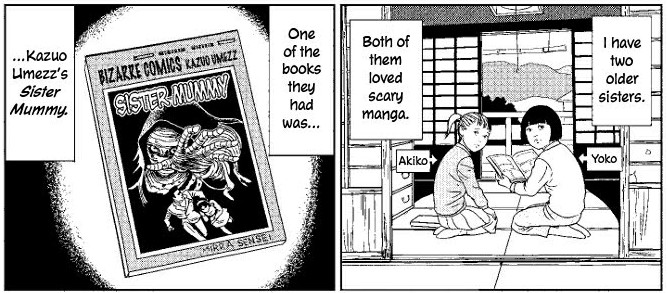
Venus in the Blind Spot — by Junji Ito, published by VIZ Media
It’s always a good month when there’s a new Junji Ito book on the horizon. I usually try not to read review copies of his stuff, because I want the experience of buying and reading the book. But this time, I just felt really compelled to write a review for Comics Beat. I really loved it; I think it might be the strongest of his anthology collections available in English so far. I was especially excited to see his adaptation of Edogawa Rampo’s creepy short story, “The Human Chair.” Ito did not disappoint — I had the same visceral reaction to this manga version as I did the original prose. My favorite offering in this collection has got to be “Master Umezz and Me,” an autobiographical piece where Ito talks about his relationship with Kazuo Umezz’s work. I have this (perhaps futile) hope that this story will inspire English-language readers to become more interested in Umezz’s work so that we can have a reprint of Cat-Eyed Boy….
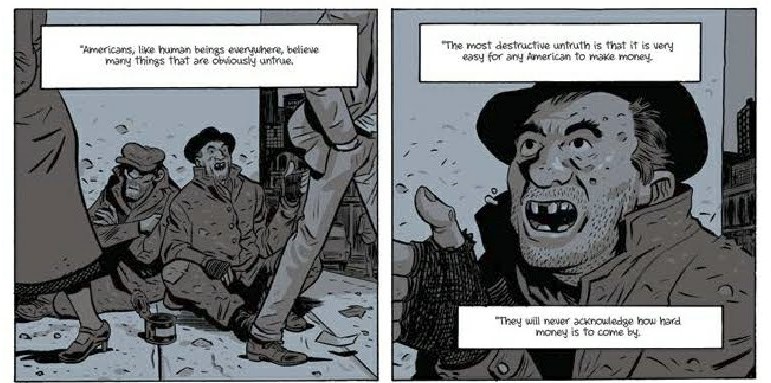
Slaughterhouse-Five, or the Children’s Crusade — written by Kurt Vonnegut, adapted by Ryan North, illustrated by Albert Monteys; published by Archaia, available September 15, 2020
I was in an airport on my way to Japan when I learned about Kurt Vonnegut’s death. It was a huge blow to me, though I had only read a couple of his books at that point. Vonnegut was a huge influence on me as a teenager, and many of his ideas remain an integral part of my personal philosophy. I was thrilled when I found out Ryan North, the writer behind Dinosaur Comics and The Unbeatable Squirrel Girl, was responsible for writing an adaptation of Slaughterhouse-Five. While I think that this comic is best appreciated if you’re already familiar with the original novel, I thought it was incredibly well done. I especially appreciate the in-story acknowledgement that it is an adaptation, talking about Vonnegut in the third person and pointing him out in crowd scenes to give the reader added perspective on his role during World War II. I’m not worried that Vonnegut will ever become an unknown name, but I like to think that this graphic novel version of one of his most beloved novels will help keep his legacy current.
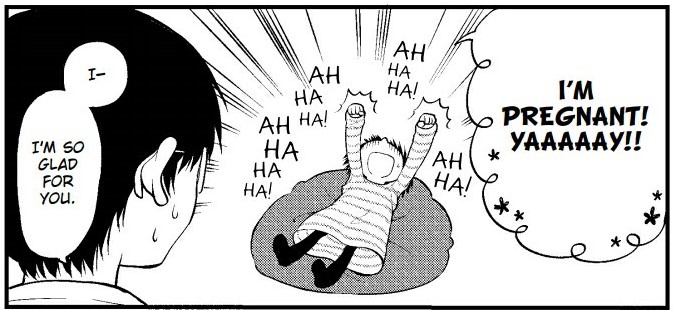
I Don’t Know How to Give Birth — by Ayami Kazama, published by Yen Press
I have been waiting for this manga forever. It was originally intended for release around my own due date, but delayed twice over. Needless to say, I was thrilled when I finally got my hands on it. I’ve mentioned before that I intend on writing a full reflection on pregnancy through comics, and the real reason I haven’t already is because I was waiting to read this, the only manga translated into English that deals directly with pregnancy. In it, Ayami Kazama talks at length about her struggles with infertility, the excitement of finally becoming pregnant, the struggle to find maternity underwear, and the uncertainty of becoming a parent. Though her experience was very different from my own, I always appreciate hearing other moms talk about pregnancy and birth. It really reinforces for me that there’s no single correct way to have a baby or to be a mom, and I find that really reassuring as a new parent, myself. Kazama’s husband, Azure Konno (also a mangaka), has little pages at the end of each chapter where he mentions his own experiences of his wife’s pregnancy. I thought this was a really nice touch, since it takes (at least) two people to make a baby! I Don’t Know How to Give Birth also reminded me a lot of chii’s The Bride Was A Boy, in that it was an autobiographical manga that used factual information to gently educate its readership on the topic at hand. I think this is a great read for anyone, but it will be of special interest to new parents, or those planning on having children.
A pretty solid lineup for August, if I do say so myself! September is gearing up to be busy (and I always get busier in the fall, but let’s see what happens since COVID prevents me from going anywhere). Hopefully I’ll have a nice little roundup for you next month, as well. Until then, stay well!
autobio comics
Black Creator Spotlight: Bianca Xunise
I’m kicking off the Black Creator Spotlight with a profile on Bianca Xunise, a Chicago-based artist whom I have followed on Twitter and Instagram for years now. I initially began following her because of her involvement in the Chicago goth scene, and for her punk and goth related jokes, outfits, and musings. In the course of the last few years, I have been treated to her comics as well, many which center around her experiences with racism, sexism, and mental health. Xunise is a cartoonist whose work has appeared in many places including Vogue and The Washington Post, though you may recognize it most readily from The Nib.
A few weeks ago, I finally purchased four of Xunise’s mini-comics through her Gumroad: The Ignatz Award-winning Say Her Name, Rock Against Racism, GothThrob Magazine #1, and The Devil’s Music. Having paid attention to her posts, I knew what to expect and that I would enjoy it. In fact, I hope to one day re-purchase all four, along with more of her other works, in a physical format.
Xunise’s artwork reminds me, favorably, of Charles Schultz’s Peanuts. Her figures have sweet round faces and the easily readable facial expressions that are essential to the cartoon medium. A major important difference is that Xunise’s focus is frequently autobiographical, centering the narrative on the experiences of being a Black woman in the alternative music scene, rather than on a little white boy in Everytown, USA, with only one Black neighbor. Her straightforwardness and willingness to be vulnerable with her audience about her life give her comics the weight of truth.
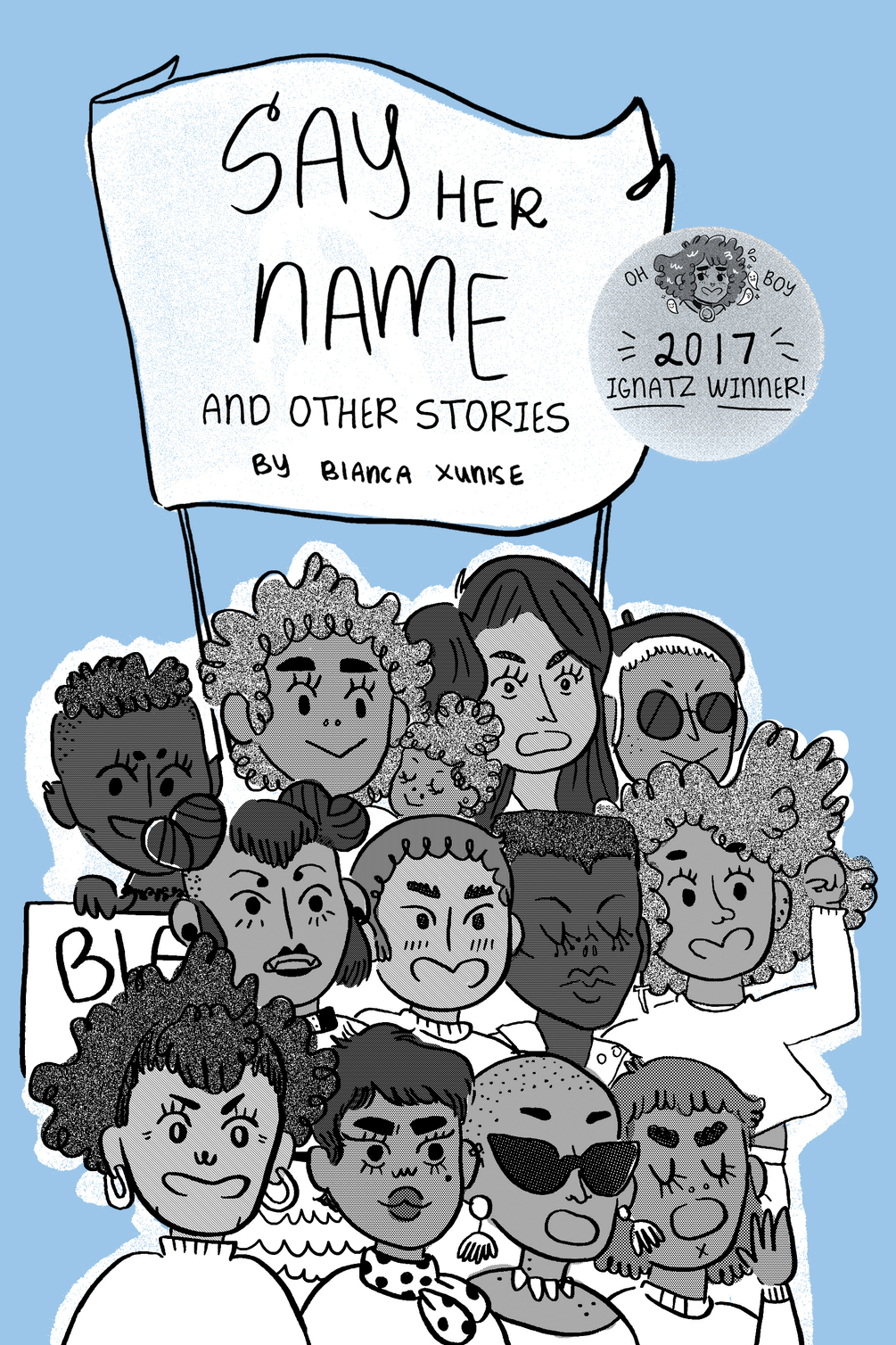
Say Her Name, a 2017 Ignatz winner, contains several short stories in which Xunise uses anecdotes from her own life to illustrate the larger, systemic issue of racism in America. The first story relates Xunise’s fears for her brothers in the wake of the shootings of young men like Michael Brown, Trayvon Martin, and Philando Castile, as well as her father’s run-in with a police officer who mistook him for another Black man. She discovers that even she, model citizen though she is, is not immune to the judgments of the police. She also details an incident of microaggressions around Halloween, and the time her childhood friend levied a slur at her, effectively ending their friendship.

Xunise learns as a teen that her own mother had a similar experience when she was young, common ground that has likely existed between Black parents and their children for generations. Xunise’s relationship with her mother seems complex, and she touches more on her mother’s parenting style in The Devil’s Music, where she reveals her mother’s preoccupation with her return to the Christian church. This dedication to her religion meant that Xunise’s mother did not allow secular music in the house — unless it was from her own childhood. This seems like an unlikely origin story for a person with so much pop culture knowledge, but it is Xunise’s deep understanding of music history that drew me to her work in the first place.

To that end, I was very drawn to Rock Against Racism, which appealed to my interest in music and history. Somehow, I came in to this mini not knowing much about the Rock Against Racism movement (just a passing reference here and there), and Xunise lays out the basics in a clear, engaging way. She reminds readers that music has always been political, for better or for worse. Beginning with the story of a drunken hate speech from Eric Clapton in 1976, Xunise then launches into the various counterculture music movements that sprung up in the 70s and 80s. I especially appreciate the way she highlights musicians of color who are too frequently overlooked in such overviews of music history. I know that I am guilty of not paying attention to such artists, and Xunise’s brief profiles of artists like Mona Baptiste, Pauline Black, and Steel Pulse (as well as her discussions about them and others on Twitter) have inspired me to dig a little deeper when looking for something to listen to.

After all, music is the main reason I started following Xunise. I was really excited to read GothThrob Magazine #1, which talks about her various gothy loves. Included in this list are Dave Vanian of The Damned (pictured on the zine’s cover), the Mothman, and the Chicago goth scene itself. The tone of this mini is much lighter than the others, a sweet indulgence that moves beyond Xunise’s worries and woes to her joys. She makes a point to talk about two incredible Black woman musicians who helped shape rock music: Sister Rosetta Tharpe (one of the first musicians to play the electric guitar way back in 1945) and the exuberant Poly Styrene, of the punk band X-Ray Spex. Xunise is flexible in her definition of punk music to being more about pushing against the system that solely focused on a style of music, a philosophy which I share and am glad to see touted by an artist I respect so much.
Recently, Xunise hosted a “Comics as Resistance” workshop with The Believer, which you can watch here. If you do watch, I encourage you to support her Patreon. Using comics as a form of protest or resistance highlights Xunise’s background as a person in the alternative scene, conjuring up images of punk zine fests. Though Xunise definitely fits into that category as a punk creator, I would say that in many ways her work bridges a gap, pulling readers into her orbit who might not otherwise have experience in the goth or punk arena with her incredible ability to reach out authentically to her audience. Once again, it is her deep knowledge and openness of heart that keep me coming back for more of her work. I will absolutely be keeping a close eye on her career; I can’t wait to see what she has on the horizon!
July Favorites
It’s been another bustling, busy month, but I made good on my promise and read more comics in July! I’m still more behind on my reading than I’d like to be, but it feels good to get back into some kind of routine (even if I have been doing all my work from our new couch instead of at my desk…).
At the top of the month, I started recording a four-part series with the wonderful gentlemen of the Manga Machinations podcast, a retrospective of Akiko Higashimura’s EISNER-AWARD WINNING Tokyo Tarareba Girls. Long-time readers and folks who follow me on Twitter will know that this is one of my absolute favorite modern series. I wrote about my feelings on the first volume ages ago, and those feelings have multiplied and intensified with each passing volume. By the time this post goes up, we’ll be three-quarters of the way through the retrospective. I hope that those of you who have had a chance to read the series will listen to our discussion of it and give us some feedback on your feelings about Higashimura’s love letter to 30-something women and the problems they face. It’s thrilling that I was able to talk about this series in the midst of its Eisner victory. Deb Aoki asked for some of my thoughts on the win and its potential affect on sales for her Answerman column over on Anime News Network, as well. I can’t reiterate enough how every manga fan should follow Deb on Twitter if they want all the latest news from cons and publishers. She’s a force of nature with her Tweeting skills!
I’ve also continued my work for The Comics Beat with reviews for Beastars volume 1, Junji Ito’s Smashed anthology, and the first two volumes of Satoko and Nada. Writing long-form manga reviews is my favorite job right now, hands down. It’s nice to be able to take the skills I utilized recommending manga to customers through working at Comicopia and translate that into recommending manga to readers all over the world. Since leaving the shop, I had been feeling a little isolated from the comics community, but writing for The Beat has helped me reaffirm my place within it and remind me that the work I do is worthwhile and (hopefully) helpful to readers.
So a lot is happening for me these days, and I’m hoping to have even more good news for you next month. But for now, it’s time to talk about what you all came to read — my favorite comics that I read in July. Some of these will likely be given the full Comics Beat review treatment in the near future, but I wanted to write about them a bit in a space where I can let my personal bias really shine through. :3

Popocomi, by various — published by Eriko Obayashi of Books and Gallery POPOTAME
I bought this wonderful anthology at TCAF and finally, finally sat down to read it. Organized by the Japanese comic shop POPOTAME, this collection features works by “underground” Japanese mangaka — something readers in the West rarely get to see. This collection runs the gamut from more straightforward short narratives to surreal or nonsensical offerings. It certainly won’t be everyone’s cup of tea, but I was really impressed with the variety and the skill on display. I was especially fond of Ikumi Nakada‘s melancholy “In a Worm-Eaten Town” and Maiko Dake‘s bubbly “FROM the BOOK SHOP.” They’re very different little glimpses into the lives of a couple of young women, but they both struck me with their ability to convey tone and emotion through the expressiveness (or lack thereof) of their characters. This collection was created in collaboration with TCAF and translated by the incomparable Jocelyne Allen, who has translated scores of my favorite books, provided interpretations for Junji Ito during TCAF, and who is a lot of fun to hang out with. The book was enthusiastically sold to me by one of the artists (whose name I unfortunately didn’t catch!), and came with a sweet little map of bookshops in Ikebukuro-Mejiro. The whole experience of buying and reading this book was unique, and it reminded me of the importance of connecting bookshops and artists with their products — something I believe in very strongly. Support your local bookstores! Support your local artists! Remember that a lot of love and care goes into putting together the works you love.
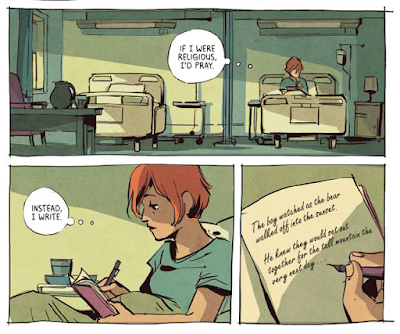
Waves, by Ingrid Chabbert & Carole Maurel — published by BOOM! Studios
I’m going to be completely honest — I sobbed through this book. The protagonist is pregnant, and the reader is made to believe this is not her first pregnancy, but that her other attempts thus far have failed. She and her wife are deeply invested in having a child, but because the protagonist’s condition is so tenuous, she is made to stay in the hospital. Unfortunately, things take a turn for the worst and the couple loses their precious son — stillborn. God, I’m starting to tear up just typing this! But the story is not just about losing the baby. It is about how that loss is used to help the protagonist push forward and find hope in a new career of writing books for children. This is an autobiographical comic with gorgeous illustrations by Carole Maurel that utilize color to great success. It’s definitely not a light read, but it is short and extremely affecting. I thought it was brilliant, even if I had to read a lot of it through blurred vision.
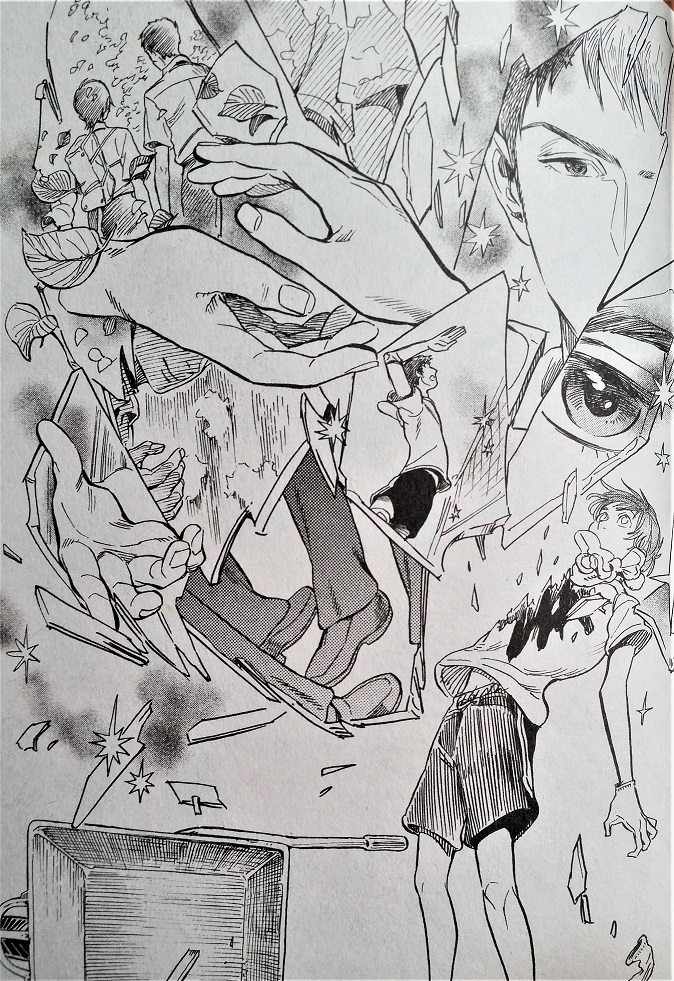
Our Dreams At Dusk, by Yuhki Kamatani — published by Seven Seas Entertainment
I have been SO excited for this release for so long, and I finally got my hands on a copy through the library. It is a little different from what I anticipated, but I’m not at all disappointed in it; rather, I think it’s great, and I can’t wait to check out the next volume which just recently came out. Protagonist Tasuku Kaname is struggling at school. Not with bad grades, but with being the new kid and being singled out for being gay. Of course, he didn’t tell anyone that he was gay, and he vehemently denies it, but the teasing comes anyway, to the point where Tasuku’s conflicting feelings nearly lead him to make a fatal decision. Luckily, he is distracted by a woman he sees in the distance who appears to be jumping to her death as well, and when he runs to see what became of her, he is confronted with her, whole and hale, and referred to by everyone in the drop-in center he found her in as “Someone-san.” Through this strange encounter, Tasuku meets others who are queer, and he is able to begin confronting his own fears about his sexuality and what it means for his life and his relationships. I find it deeply gratifying to have a fictional LGBTQ+ manga written by a non-binary creator and depicting a supportive queer network. A lot of the genuine queer works we’ve seen coming Stateside are autobiographical, and while their messages are so important, it is nice to see the field open up to fiction that isn’t relegated to BL or yuri — both of which are great in their own way, but which seldom reflect lived experiences or common concerns, especially amongst queer youth. Kamatani is know for their other manga series, Nabari no Ou, and I’m hoping that the name recognition might help get this manga into the hands of those who need it most — though my guess is that it’s already doing quite well based on the force of its subject matter alone. The importance of the story and characters aside, Kamatani’s artwork is gorgeous — fluid and expressive, with a boldness that I wasn’t expecting based on the dreamy cover designs.
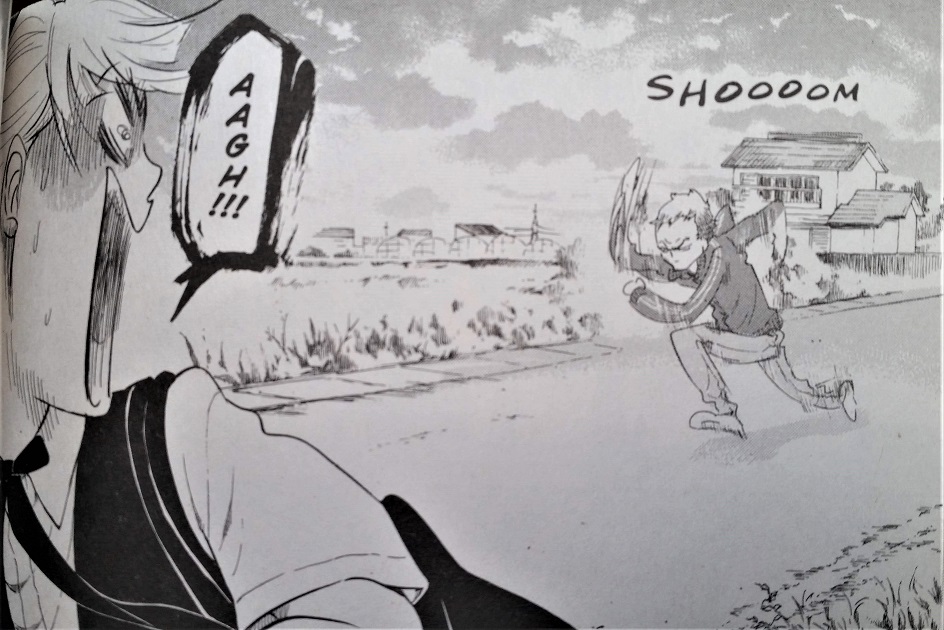
Blank Canvas, by Akiko Higashimura — published by Seven Seas Entertainment
This month I finished reading Tokyo Tarareba Girls and then immediately delved straight into Higashimura’s autobiographical work Blank Canvas, where she details her teenage experience of attending art classes outside of school to help boost her portfolio for college, and her relationship with an old, ornery art teacher who helped her improve immensely. I love Higashimura’s no-holds-barred, unflattering depiction of herself at that age: cocky, under-motivated, and underneath everything, deeply uncertain. This helps to shed new light on Higashimura’s many successes as a mangaka, reminding readers that while there might be something about her that is innately talented, it took years and years of work and drilling to become the master she is today. I could have used this manga as a self-assured teen, if only to light a fire under my butt to work harder at my dreams and to seek out the guidance I didn’t really think I needed. I’m still a little too cocksure sometimes, so it’s amazing to see someone I respect as much as Higashimura humble herself for her audience in this way. I’m not sure I’d have the same confidence if I were her, but she has absolutely, 100% earned it. And besides, she seems like the kind of teen it would have been fun to be friends with.

Classmates, by Asumiko Nakamura — published by Seven Seas Entertainment
There was a time, not too long ago, where I was very skeptical of Seven Seas’s output. They published a lot of works that were not for me in the extreme, with plenty of fanservice and an uncomfortable blurry line between what constituted age-appropriate content and what did not. And yet here I am today, promoting three of their recent manga with nothing but my highest accolades. At some point around the time they published My Lesbian Experience With Loneliness, Seven Seas took a deep dive into queer stories and have really set the standard for what types of manga readers are really scrambling for. Among those is one of my all-time favorite manga, Classmates. DMP had already owned this license, for digital distribution only, so I had read it a couple years back. I was struck then by a few things: the genuine sweetness of the story itself, and Asumiko Nakamura’s bizarre, stretchy, almost uncomfortable art style (which I adore). In my twenty-ish years of manga reading, I’ve read a lot of BL. A vast majority of it has been purely horny trash, stuff I didn’t particularly even like but felt compelled to read just to see if I could find the hidden gems. And the hidden gems are there, but you have to wade through scores of tropes: near-rape or rape scenes, coercion, incest, abuse, student-teacher relationships…basically, the tawdry, the inappropriate, and the obscene. But sometimes a manga like Classmates comes along — a sweet story about two teenage boys who fall in love and stumble through a predictable teenage relationship without too much meddling from the outside. And it’s a happy manga, one that brightens your day with its effortless charm and its delightfully wacky artwork. Nakamura’s long-limbed, long-lashed, almost alien-looking characters seem suited to eroguro works or philosophical stories — and she’s done things like that, too (I’m thinking specifically of Utsubora) — but somehow her distinct flair makes the characters’ expressions of amorousness, embarrassment, and teenage hilarity all the more effective. I’m so glad that this series has gotten the print treatment, and I hope that it draws in many, many new readers!
Phew! A really long one this month to make up for June’s scarcity. It’s nice to be back on a roll with reading — let’s hope I can keep it up for a while. Until next month, I wish you all happy reading!
May Favorites
As I’m writing this, I’m gearing to move out of my apartment and into a new, slightly bigger one (the better to accommodate my ever-increasing manga collection, right?), and I’m surrounded by boxes and boxes of my stuff. There’s nothing that makes you want to consider a life of asceticism quite like moving. May has been very much a transitional month for me, in more ways than just a change of address.
I already wrote a little bit about my adventures at TCAF. That sojourn sparked a lot of excitement and motivation within me, so hopefully I’ll be stepping up on my manga writing even more in the aftermath — gotta ride that wave of inspiration for as long as possible!
And something I haven’t mentioned yet is that I have contributed a short piece on manga basics to the upcoming CBLDF Presents Selling Comics: The Guide to Retailing and Best Practices in the Greatest Modern Art Form. I am so, so excited to have been asked to do this; about six years ago, CBLDF and Dark Horse collaborated on a similar book all about manga that featured writing from many intelligent, excellent writers whom I greatly admire. And since I have a lot of strong feelings about comics retail and selling manga in particular, this felt like an excellent first foray into comics print publication for me.
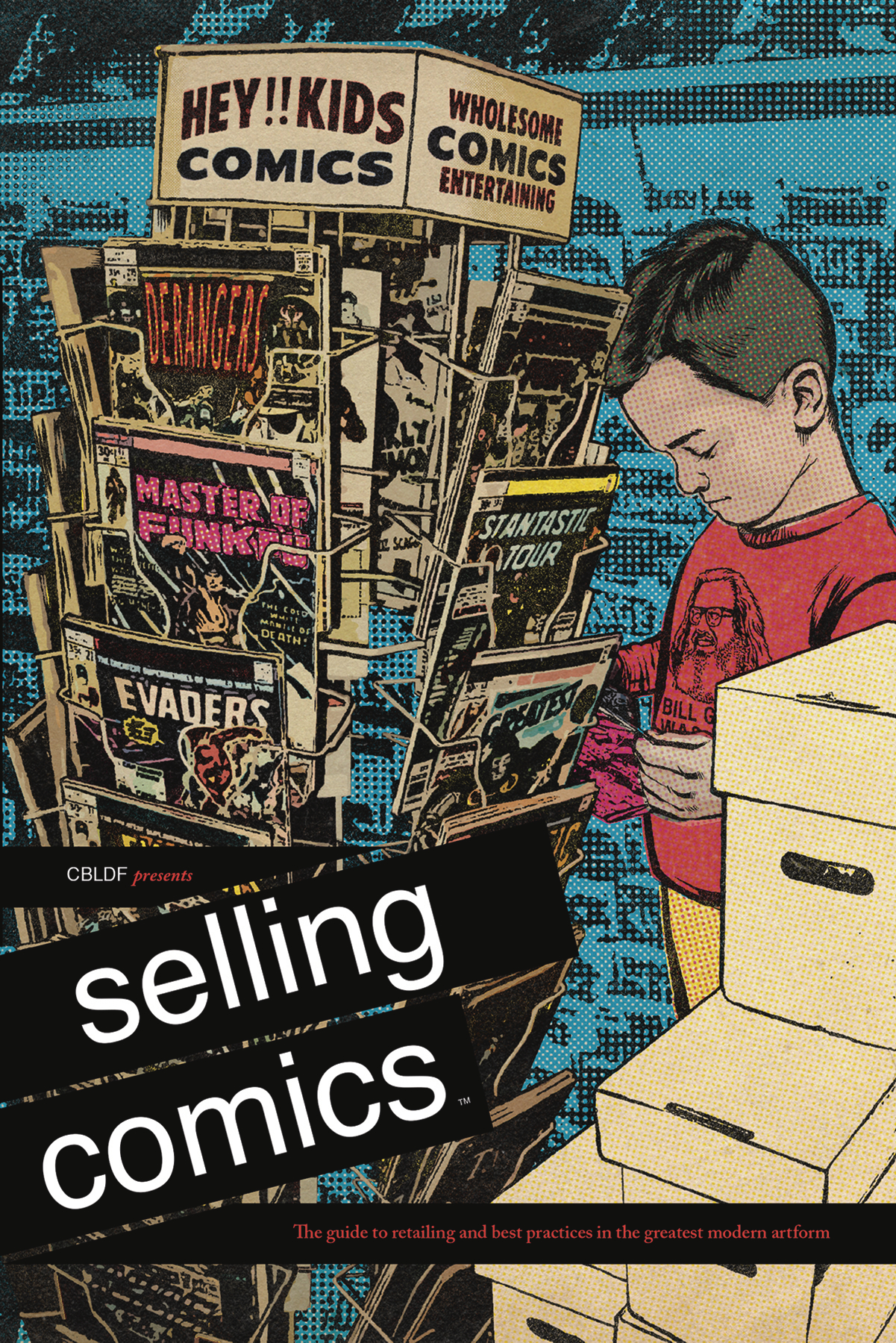
In between all the travel and writing, I did get a chance to read some really excellent books of all stripes. As usual, it’s time for me to highlight my favorite comics for the month!
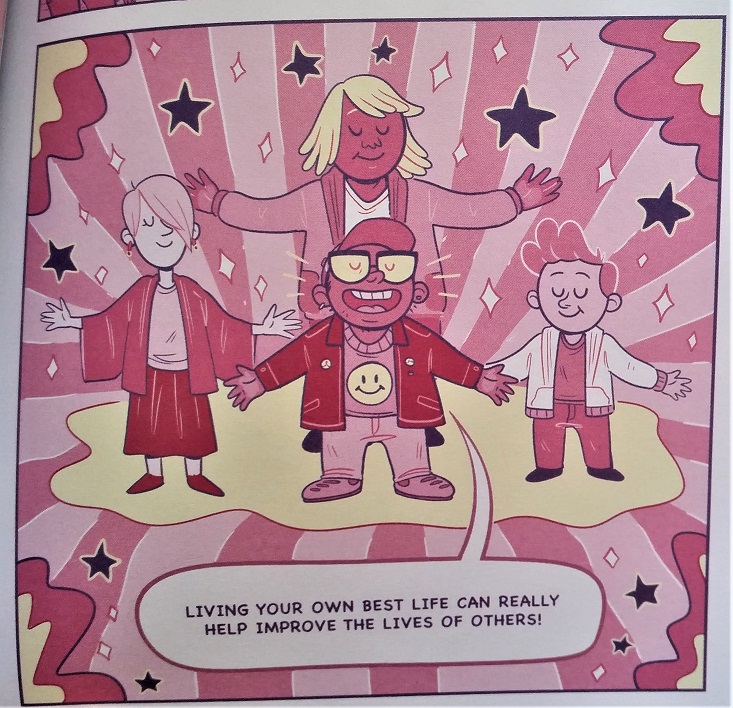
A Quick & Easy Guide to Queer & Trans Identities, by Mady G & J.R. Zuckerberg — published by Limerence Press
Last year, Oni Press’s Limerence imprint published A Quick & Easy Guide to They/Them Pronouns, which I thought was absolutely excellent, and I was gratified that we sold a ton of copies at Comicopia. With its friendly, non-judgmental tone and low price point, it was a really nice, gentle introduction to the topic of non-binary genders for people of all backgrounds. And so, I was very excited when Queer & Trans Identities was announced. It’s slightly less auto-biographical, but equally kind in its delivery with the added bonus of covering a lot of ground succinctly. There are two “stories” going on at the same time: A snail is teaching other snails all about different human identities and expressions, and a fantasy world populated by “sproutlings” shows the identity progression of one of its citizens. The artwork is adorable, bright, and fun, and the back matter encourages readers to create their own “sprout-sona” and design matching friendship jackets. I think what I enjoyed most about this guide was its dedication to inclusivity, and its patient guidance through myriad identities and sexualities — and a wonderful chapter on forging healthy, caring relationships that everyone, regardless of gender or sexuality, could use. I think this is a wonderful addendum to any coming-of-age talk that a parent or teacher might have with a young person, and it provides resources for further research as well. Growing up, I had to figure out my own ideas of gender and sexuality without the guidance of any adult queer person, and even though I have no real regrets or concerns about my own path, I think this is an endlessly valuable guide that I and my peers could have really benefited from.
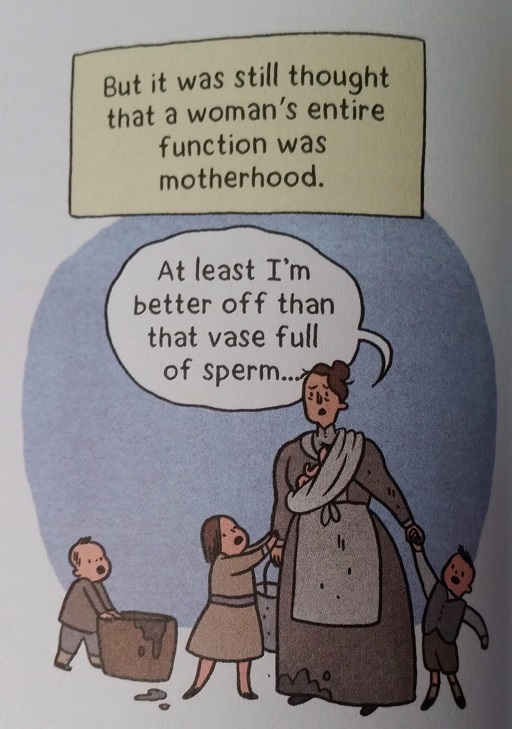
Kid Gloves: Nine Months of Careful Chaos, by Lucy Knisley — published by FirstSecond
It is a really, really scary time to be a person with a uterus in the United States right now. Abortion rights are being overturned state by state, causing people like me — even those of us who want to get pregnant and have children! — to worry about our autonomy and our value in the eyes of the law. So it was a really interesting time to decide to read Lucy Knisley’s autobiographical account of her very high-risk pregnancy — a book I had been patiently waiting to read since it came out, but scores of people already had on hold at my local library. This was actually the first of Knisley’s books I’ve ever read, though I do follow her avidly on Instagram, and it was worth the wait.
From the time most girls are born, there is an emphasis on them becoming mothers, whether intentionally or by accident. There is a lot of burden placed on girls and women to have babies and also to prevent them, lest they be marked “fast” or “easy.” But what I think doesn’t get talked about quite enough is how complicated and often dangerous pregnancy is — or how little control a pregnant person has over what happens to their body and their baby, in the grand scheme of things. So I appreciated Knisley’s openness about her two miscarriages, her extraordinary battle with constant morning sickness, and her concerns about pre-eclampsia that went unaddressed by her doctor. All these deeply personal and evocative anecdotes are peppered with chapters on the history of pregnancy and gynecological medicine, which is a personal interest of mine anyway (I love the Sawbones podcast!). And though she struggled so fiercely through her pregnancy, it is so clear how much she loves her son, how grateful she is for his presence in her life. This is an excellent read for our times, a good reminder that pregnancy and motherhood should never be forced upon a person, that it is a great risk and a great responsibility.
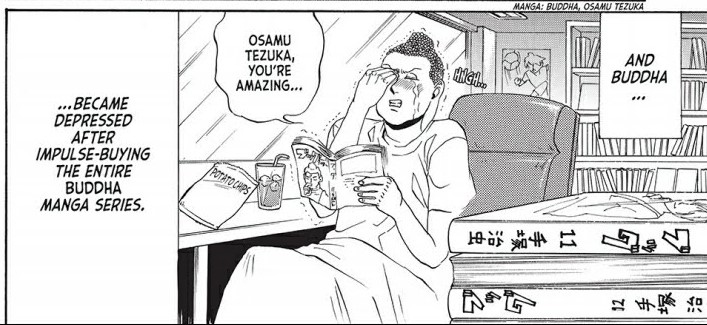
Saint Young Men, Volume 1, by Hikaru Nakamura — published by Kodansha (digital only)
I feel as though I’ve been waiting for this manga all my life. It’s commonly known that mangaka Hikaru Nakamura has been hesitant for Saint Young Men to have an English-language release, for fear that it might stir up some religious controversy. But as a proudly lapsed Catholic, I am ecstatic that it has finally made it Stateside. I am a huge fan of religious comedies; my favorite novel is Terry Pratchett and Neil Gaiman’s Good Omens, and Dogma is pretty high up on my list of favorite films. So the premise of Jesus Christ and Siddhartha Gautama kicking it in a tiny apartment in Japan just for fun is exactly in my wheelhouse. I appreciate anything that humanizes the figures that people worship, that allows common people to identify with these holy beings. I think that at the root of spirituality is the understanding that at our most basic, we are all connected to one another. And somehow, I think that comedy often conveys this idea better than any fire and brimstone sermon, catching us with our hearts and minds more open than they would be when we’re expecting to be lectured. Nakamura has a knack for finding the little things that elicit the big laughs — like how Jesus is so enamored of the fact that teenage girls think he looks like Johnny Depp, or how Buddha loves Osamu Tezuka (and especially Tezuka’s biography of Buddha himself). She’s also extremely adept at illustrating extreme expressions and inserting funny little tidbits, like the text on the T-shirts that Buddha screen-prints for the two of them. I really hope that this volume sees a lot of success so that maybe a print version will follow along soon!
It looks like I covered some heavy territory this month — gender identity, pregnancy and parenthood, and religion. But I was left with feelings of immense peace and gratitude after reading all these books, and I was able to reflect on my own ideas and beliefs without feeling judged or confused. It’s a rare thing, in our world today, to come away from hot-button issues feeling refreshed rather than completely exhausted and demoralized — and trust me, I’ve spent plenty of time there lately, as well. I always appreciate when reading can both be informative and act as a refuge, as a tool of empowerment to be wielded in my day-to-day life. We are very lucky to see these kinds of works being published, and I can’t wait to see what else we can look forward to in the future.